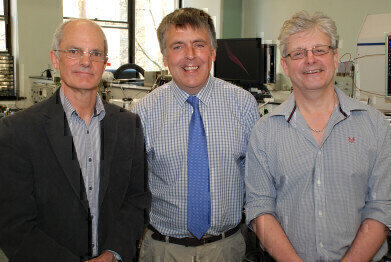-
 From left Rob Brown, Gareth Parkes, Mike Reading
From left Rob Brown, Gareth Parkes, Mike Reading
News
Nanoscale Chemical Imaging Techniques Evolving from Unique Algorithm
Jun 29 2015
Leading innovator Professor Mike Reading and the University of Huddersfield have teamed up to develop new analytical techniques based on the unique algorithm TASC (Thermal Analysis for Structural Characterisation), which Professor Reading invented in his the capacity as founder and research director of the company Cyversa. The firm Linkam, which manufactures hot stages for optical microscopes, has now incorporated TASC into one of its products. The result is an industry-leading system for the characterisation of materials which is currently being evaluated by Dr Sheng Qi in the School of Pharmacy at the University of East Anglia (in this issue).
As a part-time research professor at Huddersfield he is now collaborating with scientists based in several department and schools, with a group currently working on a ground-breaking extension to the TASC algorithm named Chemical Imaging by Dissolution Analysis (CIDA) – a nanoscale method for studying the distribution of components in solid mixtures.
“It will be used, for example, to understand the ways in which the dissolution behaviour of solid pharmaceutical formulations depend on the way these formulations are prepared,” said Professor Rob Brown, Director of the Materials and Catalysis Research Group in the Department of Chemical Sciences and a collaborator on the CIDA project. Also involved will be Dr Gareth Parkes of the Department of Chemical Sciences, Professor Barbara Conway in the Department of Pharmacy and Dr Leigh Fleming from the Centre for Precision Technologies.
Research Fellow Dr Muhammad Usman Ghori is working with Professor Reading on the development of CIDA. He is using the Atomic Force Microscope in the School of Computing and Engineering to image composite materials as they are treated with selective dissolution media. Dr Ghori completed his PhD (Drug Delivery) in 2014, under the supervision of Professor Barbara Conway.
“The TASC algorithm, as incorporated into the system marketed by Linkam, will be further enhanced as a result of the University of Huddersfield collaboration, but it already has unique capabilities,” said Professor Reading.
“It enables the measurement of transition temperatures to be carried out on a very small scale in a precisely-defined place,” he said. Crucially, the TASC system enables the user to analyse the effects of heat on different parts of composite materials, which normal thermal analysis techniques do not allow.
Professor Reading is delighted that he and his company Cyversa have forged a partnership with the University of Huddersfield, which, he says, has “a culture that is so supportive of innovation”. He himself has worked in both the industrial and academic sector and has a long track record in the field of thermal analysis and imaging techniques.
Digital Edition
Lab Asia Dec 2025
December 2025
Chromatography Articles- Cutting-edge sample preparation tools help laboratories to stay ahead of the curveMass Spectrometry & Spectroscopy Articles- Unlocking the complexity of metabolomics: Pushi...
View all digital editions
Events
Jan 21 2026 Tokyo, Japan
Jan 28 2026 Tokyo, Japan
Jan 29 2026 New Delhi, India
Feb 07 2026 Boston, MA, USA
Asia Pharma Expo/Asia Lab Expo
Feb 12 2026 Dhaka, Bangladesh


















